Manta Ray
Manta rays are the biggest rays in the world
Advertisement
Manta Ray Scientific Classification
Read our Complete Guide to Classification of Animals.
Manta Ray Conservation Status
Manta Ray Facts
- Prey
- Zooplankton
- Main Prey
- Fish, Plankton, Shrimp
- Group Behavior
- Solitary
- Fun Fact
- Manta rays are the biggest rays in the world
- Biggest Threat
- Fishing, harvesting for international trade
- Most Distinctive Feature
- Broad, flat bodies
- Other Name(s)
- Devil fish
- Gestation Period
- 12 to 13 months
- Optimum pH Level
- 6 - 9
- Habitat
- All world oceans
- Predators
- Sharks, Humans, Killer Whales
- Diet
- Carnivore
- Type
- Fish
- Common Name
- Manta Ray
- Number Of Species
- 2
- Average Clutch Size
- 2
- Slogan
- Can grow up to 9m wide!
View all of the Manta Ray images!
The manta ray, which is also sometimes called the devilfish, is the largest ray in the world.
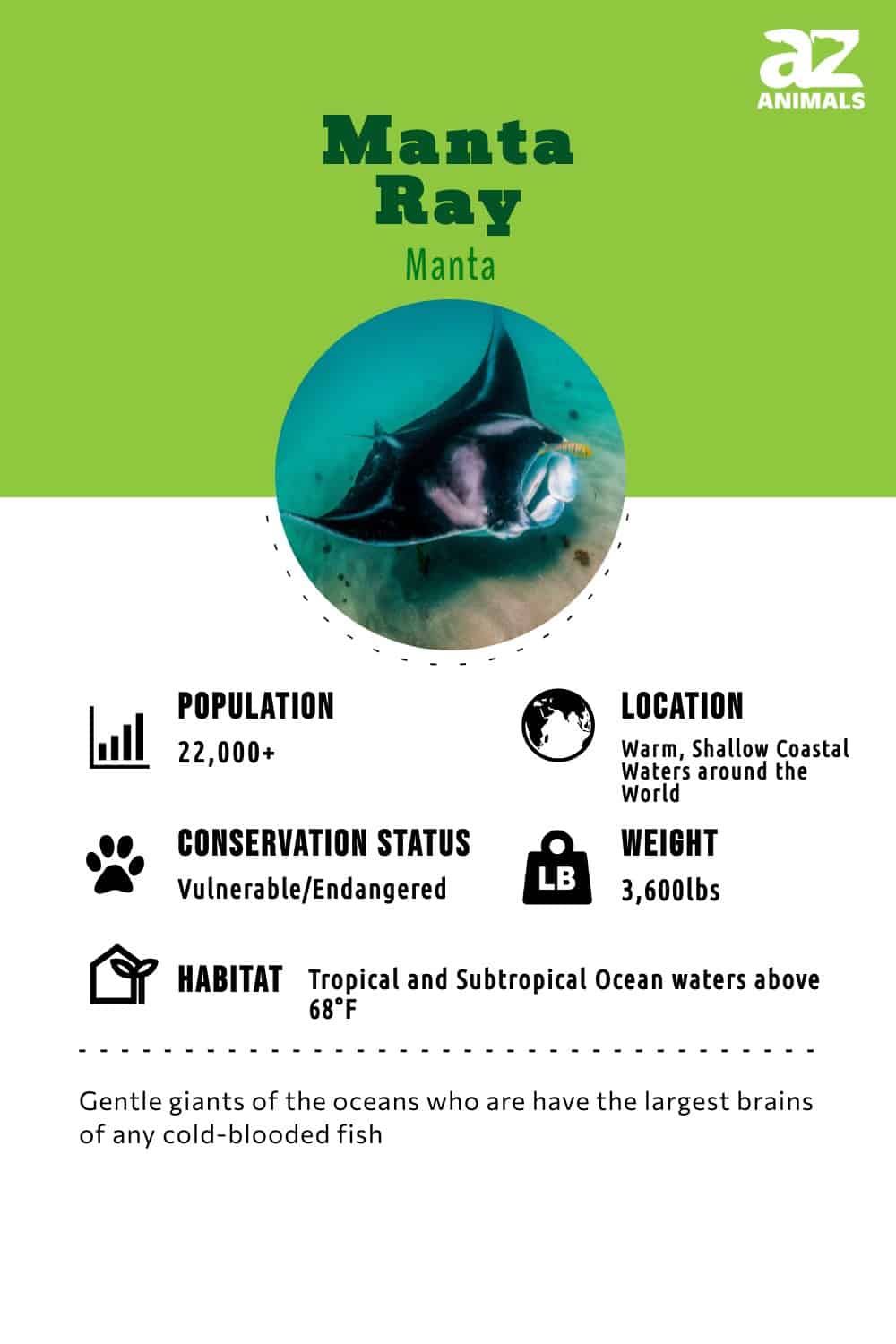
Highly intelligent and mostly solitary, they are found in all of the world’s oceans except for the freezing cold waters of the Arctic and Southern Oceans. Long living and slow to reproduce, the species is vulnerable to overfishing and being harvested for international trade. Desptie this, these brilliant creatures are incredibly friendly to human divers, often swimming up to greet them. You can learn all about the gorgeous, misunderstood manta ray below!
Six Incredible Manta Ray Facts!
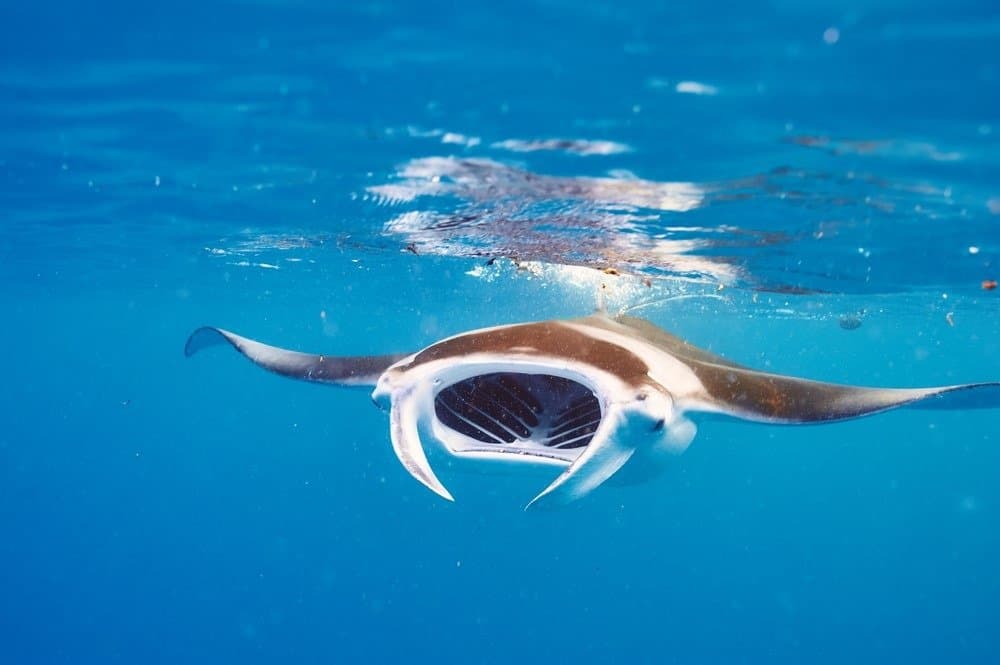
Manta rays, like whales and sponges, are filter-feeders.
©haveseen/Shutterstock.com
- Massive Brain: These fish have the biggest brain-to-size ratio of any cold-blooded fish, and they display a level of intelligence comprable to dolphins, elephants, and primates.
- Protected: Since 2011, manta rays are have been protected in international waters by an international treaty, the Convention on Migratory Species, and many countries have placed bans on fishing them.
- Distinct from Stingrays: Manta rays evolved from stingrays, but they are completely distinct species. Unlike stingrays, they don’t possess a barb that can sting, and they are not bottom dwellers.
- Two Species: Fairly recently, scientists determined that there are really two species: the giant oceanic manta ray, which is more elusive, and the reef manta ray, which is smaller and more commonly known.
- Unique Feeding: These fish use creative techniques to get the most out of filter-feeding, including performing barrel rolls to stay in one place and engaging in chain feeding, during which several fish follow each other, creating a cyclonic effect.
- Biggest: The Manta Ray is one of the biggest fish in the world. The largest manta ray ever recorded weighed 5,000 pounds and was caught off New Jersey in 1933. Manta rays have a maximum “wingspan” of up to 30 feet.
Want to know more interesting facts? Read: “10 Incredible Manta Ray Facts.”
Classification and Scientific Name
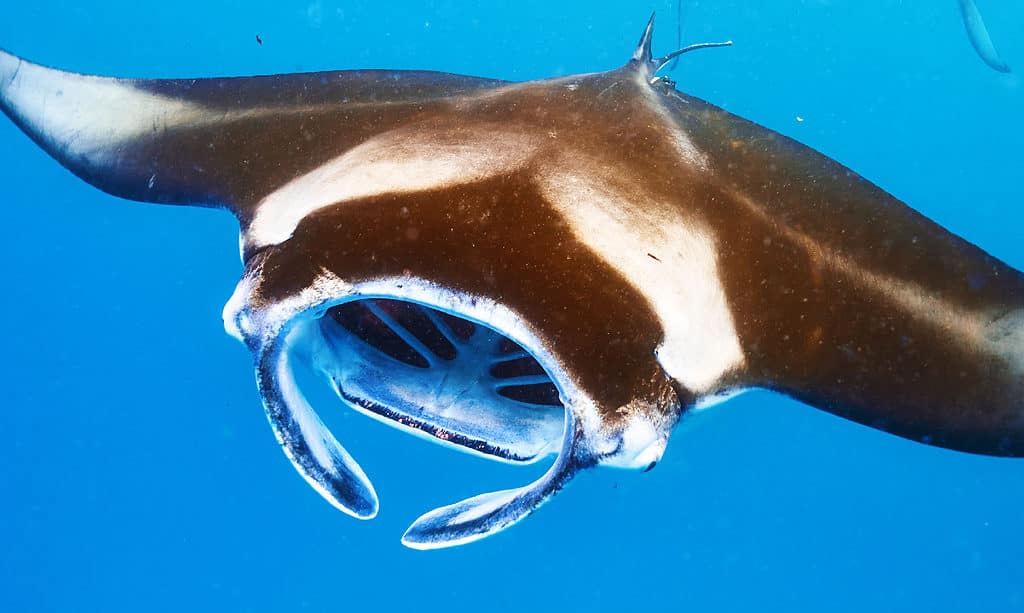
Manta rays were only recently classified into two distinct species.
©haveseen/Shutterstock.com
These fish are members of the class Chondrichthyes, the order Myliobatiformes, the family Mobulidae and the genus Manta. For a long time, the genus was believed to have only one species, M. birostris, but another species, which has the scientific name M. alfredi, has since been identified.
The word “manta” is derived from the Spanish and Portuguese word for cloak or blanket. Traditionally, manta rays were hunted and captured using traps that resembled blankets, and the name stuck.
Manta Ray vs. Stingray
At first glance, manta rays are fish that appear strikingly similar to stingrays in appearance. Both creatures belong to the order Myliobatiformes, and manta rays evolved from stingrays. They both have flat bodies with wide pectoral fins that are fused to their heads. Manta rays are not equipped with the pain-inducing barbs that stingrays are known for, but they hold on to a primordial remnant of one in the form of a caudal spine. Therefore, manta rays do not sting; stingrays do sting. Manta rays travel through the open ocean, unlike stingrays, which are bottom dwellers. Their mouths are on the front edge of their head rather than on the bottom like stingrays’ mouths are.
Appearance
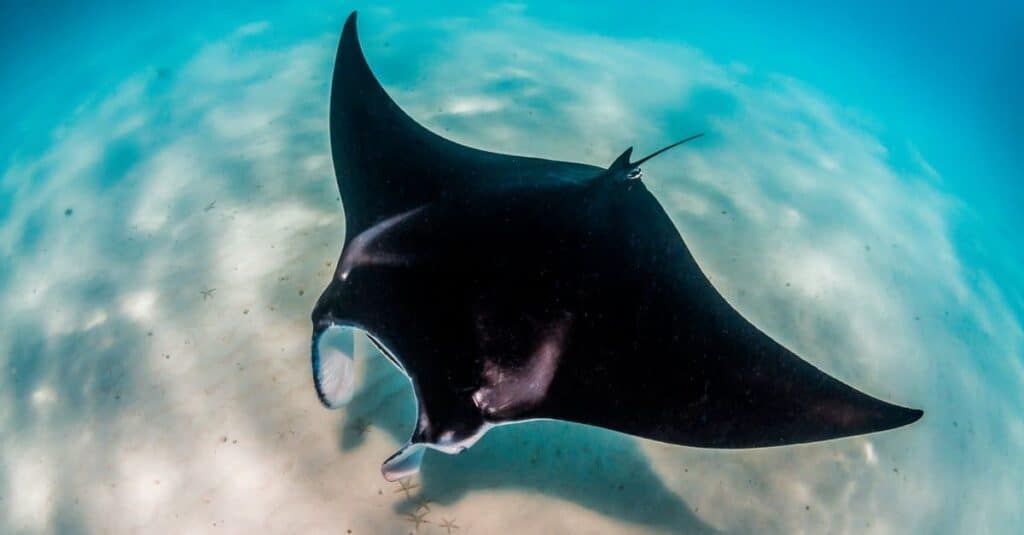
Manta rays are easily recognizable by their “horns” and massive wings.
©Aaronejbull87/Shutterstock.com
These fish have massively wide, flat, triangular bodies with pectoral fins that resemble wings when in motion. Two cephalic lobes extend out from the front of its head, lending it the alternative name “devil fish.” The wingspan of the giant oceanic manta ray can extend up to 29 feet in length, and they can weigh up to 5,300 pounds.
These large fish have lateral eyes, and their wide, terminal mouths are located on the front edge of their heads rather than on the bottom, as with most rays. The two cephalic lobes at the front of its head extend out, allowing water to be introduced to the mouth; these lobes give the fish the distinction of being the only vertebrate animal with three paired appendages.
As filter feeders, they feed by swimming with their mouths wide open, allowing zooplankton and krill to sift through rows of small rakes that line their mouths. These gill plates, or gill rakers, are heavily prized in Chinese medicine.
These fish come in two color types. Some have chevron coloring, with black backs and white bellies, while others are mostly all black. They also have distinctive patterns of spots on their bellies.
Distribution, Population, and Habitat
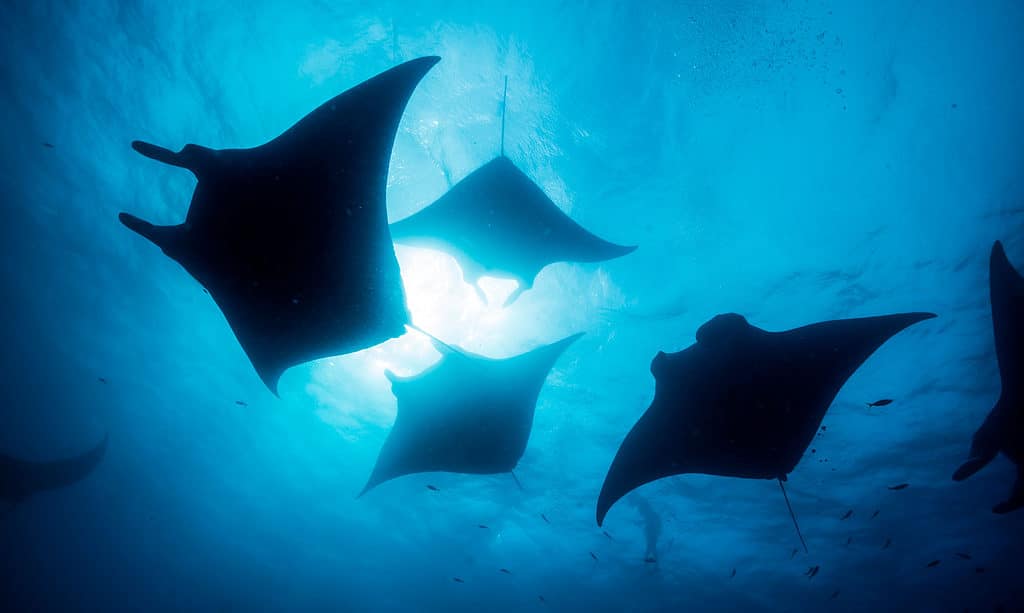
Manta ray populations are broken into small disparate groups that makes studying them especially challenging.
©divedog/Shutterstock.com
They are found in all of the world’s oceans. They are split up into small, highly fragmented populations, making it difficult for scientists to arrive at reasonable worldwide population estimates. However, they appear to live in groups of 100 to 1,500 individuals. The largest population is believed to be in Ecuador, where they congregate at places like Machalilla National Park and the Galapagos Marine Reserve.
Due to the popular use of their gill rakes in Chinese medicine, for which there is no scientific evidence of any true health benefits, these fish are vulnerable to overfishing and overharvesting. Worldwide, the gill plate trade nets upwards of $30 million per year. These fish reproduce slowly and have long lifespans, putting their populations at even higher risk.
Both species are classified as Vulnerable by the IUCN, and efforts have been made to counteract this. Many countries have banned the fishing of these fish, including Mexico, Peru, Ecuador, the Philippines, and New Zealand; since 2011, fishing of manta rays in international waters has been banned thanks to the Convention on Migratory Species.
Diet
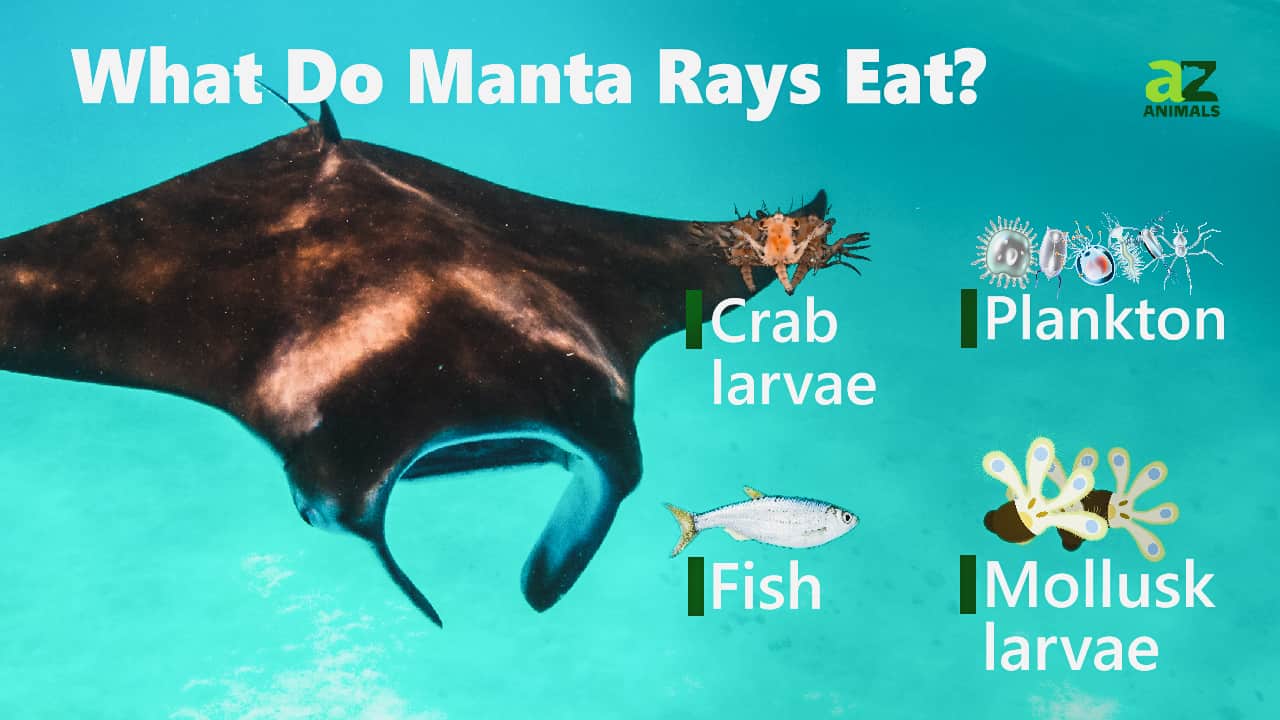
Predators and Prey
Manta Ray Predators
The primary predators of these fish are large sharks and orcas, or killer whales. Humans also greatly impact the populations of mantas through the pollution of the ocean and illegal poaching.
Manta Ray Prey
These fish are filter feeders, so their diets mostly consist of planktonic organisms like copepods and mysids. Shrimp is another popular staple, and they are also believed to consume fairly large quantities of small- and moderate-sized fish.
Reproduction and Lifespan
Little is known about the reproduction habits and development timeline of manta rays because they are difficult to observe in the wild. Typically, however, males appear to court females by following closely behind them until mating begins. Sometimes, several rays mate together in “trains”; the full moon may trigger this behavior. The male fertilizes the female’s eggs, and a single live pup is typically born after a gestation period of 12 to 13 months. The small pups are miniature replicas of adults and can take off on their own right after being born.
The average lifespan of these fish is about 50 years.
Evolution
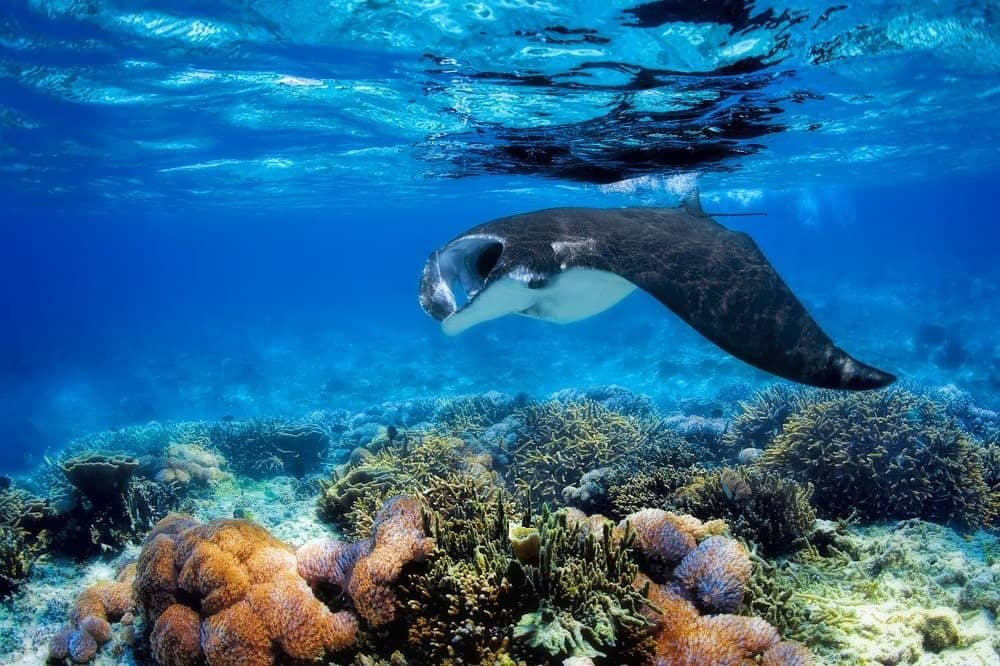
Manta rays first evolved about 20 million years ago.
©Kjersti Joergensen/Shutterstock.com
Due to the fact that their bodies are primarily composed of biodegradable cartilidge and collagen, the fossil records of Manta Rays are incredibly scant, leaving scientists to do guesswork in order to fill in the missing gaps in their evolutionary history. It is estimated mantas first branched off from bottom dwelling rays and skates around 20 million years ago. Somewhere along the line, mantas’ mouths moved from their underbelly to the front of their head, they lost their ability to sting, and grew larger, more wing-like appendages to allow them to swim with much greater ease.
Fishing and Cooking
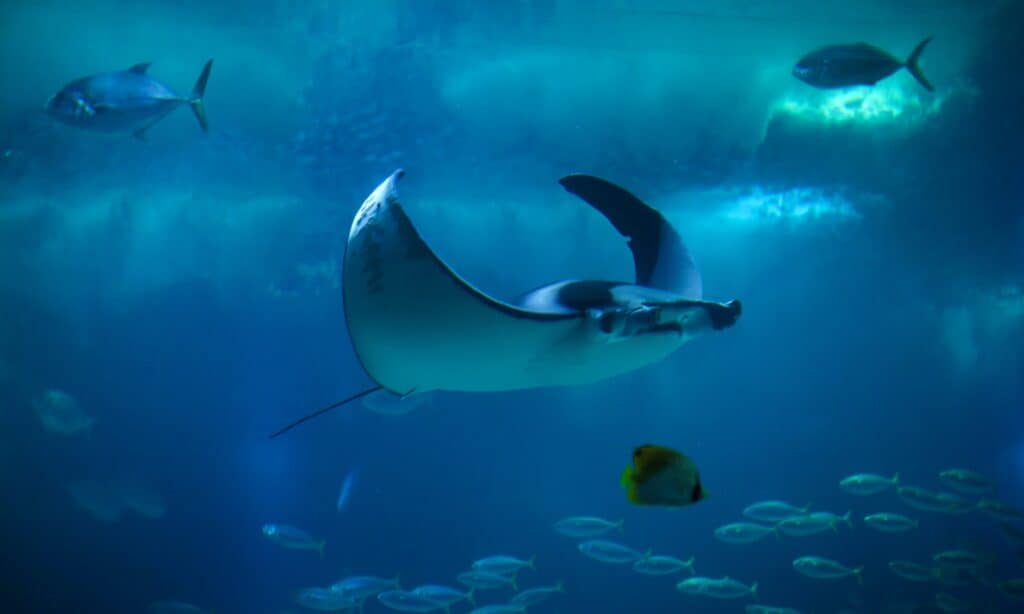
©iStock.com/wrangel
Mantas are eaten for food in some places, but they are typically treated as a rare delicacy. Scientists have no conclusive data on just how many of these unique rays are left in the ocean so bans on fishing them are in place in many parts of the world, though many poachers persist. Due to their slow swimming speeds, hunters are able to easily catch mantas with harpoons or large nets.
Types of Manta Rays
For many years, there was believed to be only one species of manta. In 2008, however, scientists confirmed the existence of two distinct species:
Giant Oceanic Manta Ray (Manta birostris)
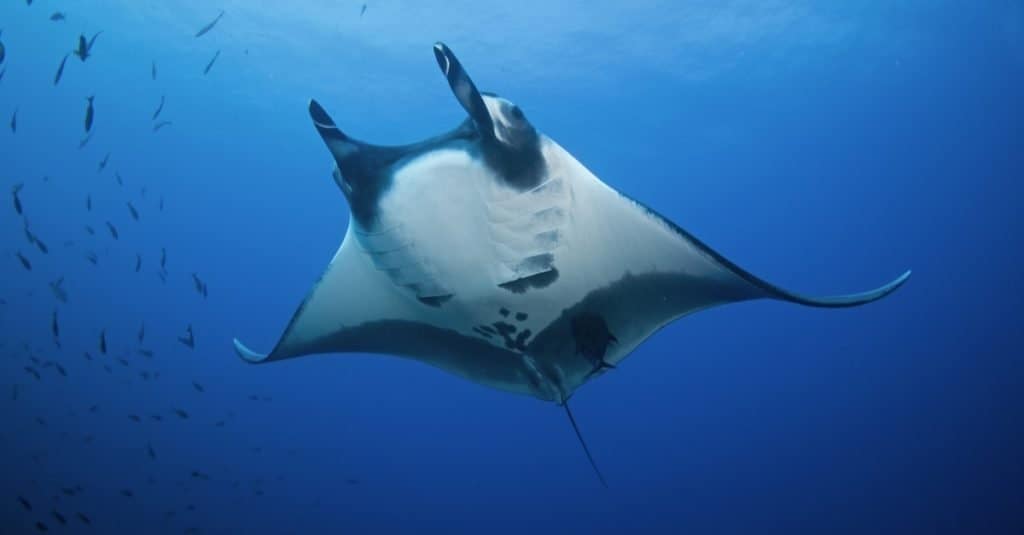
Though sometimes known as “devil fish,” Giant mantas are actually very friendly and completely harmless.
©Martin Prochazkacz/Shutterstock.com
This massive fish is found in all major oceans. It tends to spend most of its time away from shorelines in open water. They can live to be up to 60 years old.
Reef Manta Ray (Manta alfredi)
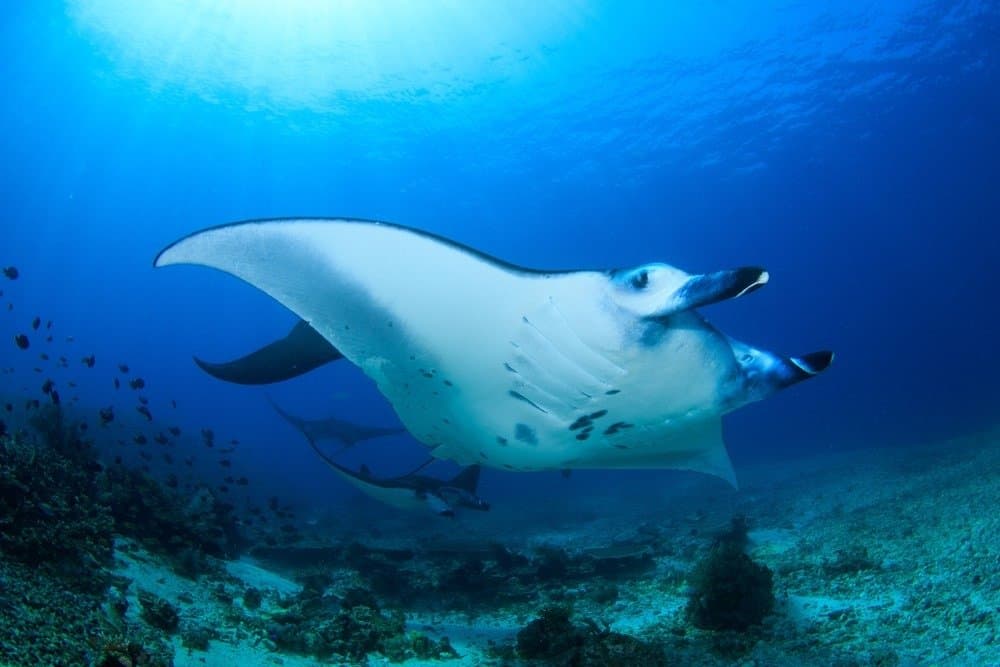
Reef Manta Rays are often hunted for the perceived medicinal value of their gills.
©SergeUWPhoto/Shutterstock.com
The reef manta ray, M. alfredi, primarily lives along coastlines in the Indo-Pacific. It is much smaller than the giant oceanic manta ray. Reef mantas are also considerably more endangered than their giant relatives.
View all 164 animals that start with MManta Ray FAQs (Frequently Asked Questions)
What do manta rays eat?
Manta rays are filter feeders, which means that they consume food by filtering ocean water through their open mouths. Water, which is filled with zooplankton, krill, and other creatures, sifts through rows of gill plates that line their mouths. The majority of their diets consists of planktonic organisms like mysids and copepods, but they also ingest shrimp and small-to-moderate-sized fish.
Is a manta ray a fish?
Yes, manta rays are a type of fish.
What eats manta rays?
In the wild, manta rays are primarily hunted by large sharks and killer whales, or orcas. Humans also occasionally consume manta rays; the fish is considered a delicacy still in some cultures. More commonly, however, their gill plates are used in Chinese medicine and are often consumed in that context.
How big is a manta ray?
The giant oceanic manta ray can grow to lengths of up to 29 feet, and they can weigh as much as 5,300 pounds. The other species of manta ray, the reef manta ray, is significantly smaller. Its disk size measures up to 11.5 feet while the giant oceanic manta ray’s disk size measures up to 16 feet.
Where do manta rays live?
Manta rays live across all of the world’s oceans. The giant oceanic manta ray spends most of its time in open water far away from shorelines while the reef manta ray primarily lives close to shore in the Indo-Pacific region.
What Kingdom do Manta Rays belong to?
Manta Rays belong to the Kingdom Animalia.
What phylum to Manta Rays belong to?
Manta Rays belong to the phylum Chordata.
What family do Manta Rays belong to?
Manta Rays belong to the family Mobulidae.
What order do Manta Rays belong to?
Manta Rays belong to the order Myliobatiformes.
What genus do Manta Rays belong to?
Manta Rays belong to the genus Manta.
What type of covering do Manta Rays have?
Manta Rays are covered in Smooth skin.
How many eggs do Manta Rays lay?
Manta Rays typically lay 2 eggs.
What is an interesting fact about Manta Rays?
Manta Rays can grow up to 9m wide!
What is a distinguishing feature of the Manta Ray?
Manta Rays have broad, flat bodies.
How many species of Manta Ray are there?
There are 2 species of Manta Ray.
What is the biggest threat to the Manta Ray?
The biggest threats to the Manta Ray are fishing and harvesting for international trade.
What is the optimal pH for a Manta Ray?
The optimal pH for a Manta Ray is between 6.0 and 9.0.
What is another name for the Manta Ray?
The Manta Ray is also called the devil fish.
How fast is a Manta Ray?
A Manta Ray can travel at speeds of up to 20 miles per hour.
How do Manta Rays have babies?
Manta Rays give birth to live young.
What are the key differences between skates and manta rays?
The key differences between skates and manta rays are appearance, habitat, feeding habits, and reproduction.
What are the key differences between devil rays and manta rays?
The key differences between devil rays and manta rays are taxonomy, appearance, size, distribution, feeding behavior, and lifespan.
What are the key differences between eagle rays and manta rays?
The key differences between eagle rays and manta rays are appearance, size, habitat, diet, and lifespan.
Thank you for reading! Have some feedback for us? Contact the AZ Animals editorial team.
Sources
- Manta Pacific Research Foundation, Available here: https://www.mantapacific.org/general-description
- NOAA Fisheries, Available here: https://www.fisheries.noaa.gov/species/giant-manta-ray
- National Geographic, Available here: https://www.nationalgeographic.com/animals/fish/group/manta-ray/

















